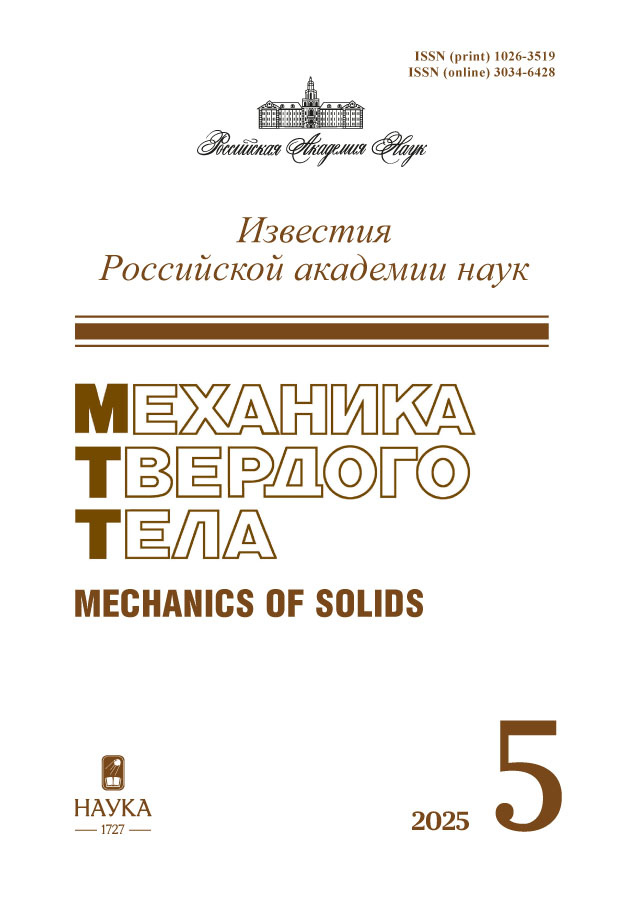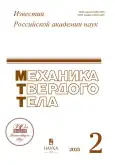Механика кровотока и деформирования стенок в брюшной аорте
- Авторы: Верезуб Н.А.1, Гандилян Д.В.1, Лисовенко Д.С.1, Пантюшов В.В.2, Простомолотов А.И.1
-
Учреждения:
- Институт проблем механики им. А.Ю. Ишлинского РАН
- Станция скорой и неотложной медицинской помощи им. А.С. Пучкова
- Выпуск: № 2 (2025)
- Страницы: 96-118
- Раздел: Статьи
- URL: https://gynecology.orscience.ru/1026-3519/article/view/686209
- DOI: https://doi.org/10.31857/S1026351925020068
- EDN: https://elibrary.ru/angerv
- ID: 686209
Цитировать
Полный текст
Аннотация
Обсуждаются медицинские проблемы механики сосудов применительно к вопросам кровотока и деформирования стенок в брюшной части аорты человека, в том числе при образовании аневризмы. Анализируются публикации, в которых изложены современные медицинские представления о гидромеханике кровотока и деформациях стенок артерий, а также в которых даются физические параметры необходимые для математического моделирования. Приводятся результаты сопряженного математического моделирования кровотока и деформаций стенок в брюшной части аорты при различных патологических процессах в ней, рассматриваемых при моделировании как механические повреждения, в том числе при наличии аневризмы. Также анализируется влияние аневризмы на процесс осаждения эритроцитов из кровотока.
Ключевые слова
Полный текст
Об авторах
Н. А. Верезуб
Институт проблем механики им. А.Ю. Ишлинского РАН
Email: lisovenk@ipmnet.ru
Россия, Москва
Д. В. Гандилян
Институт проблем механики им. А.Ю. Ишлинского РАН
Email: lisovenk@ipmnet.ru
Россия, Москва
Д. С. Лисовенко
Институт проблем механики им. А.Ю. Ишлинского РАН
Автор, ответственный за переписку.
Email: lisovenk@ipmnet.ru
Россия, Москва
В. В. Пантюшов
Станция скорой и неотложной медицинской помощи им. А.С. Пучкова
Email: lisovenk@ipmnet.ru
Россия, Москва
А. И. Простомолотов
Институт проблем механики им. А.Ю. Ишлинского РАН
Email: lisovenk@ipmnet.ru
Россия, Москва
Список литературы
- Трегубов В.П. Математическое моделирование неньютоновского потока крови в дуге аорты // Компьютерные исследования и моделирование. 2017. Т. 9. Вып. 2. С. 259–269. https://doi.org/10.20537/2076-7633-2017-9-2-259-269
- Hughes T.J.R., Liu W.K., Zimmermann T.K. Lagrangian–Eulerian finite element formulation for incompressible viscous flows // Comput. Methods Appl. Mech. Eng. 1981. V. 29. № 3. P. 329–349. https://doi.org/10.1016/0045-7825(81)90049-9
- Urquiza S.A., Blanco P.J., Venere M.J., Feijoo R.A. Multidimensional modelling for the carotid artery blood flow // Comput. Methods Appl. Mech. Eng. 2006. V. 195. P. 4002–4017. https://doi.org/10.1016/j.cma.2005.07.014
- Ladisa J.F., Figueroa C.A., Vignon-Clementel I.E. et. al. Computational simulations for aortic coarctation: representative results from a sampling of patients // J. Biomech. Eng. 2011. V. 133. № 9. P. 091008. https://doi.org/10.1115/1.4004996
- Mokhtar W. Effect of negative angle cannulation during cardiopulmonary bypass – A computational fluid dynamics study. Inter. J. Biomedical Eng. Sci. 2017. V. 4. № 2. P. 1–13. https://doi.org/10.5121/ijbes.2017.4201
- Svensson J., Gårdhagen R., Heiberg E. et. al. Feasibility of patient specific aortic blood flow CFD simulation // Lecture Notes in Computer Science “Medical Image Computing and Computer Assisted Intervention – MICCAI 2006”. 2006. V. 4190. P. 257–263. https://doi.org/10.1007/11866565_32
- Simão M., Ferreira J., Tomás A.C. et. al. Aorta ascending aneurysm analysis using CFD models towards possible anomalies // Fluids. 2017. V. 2. № 2. P. 31. https://doi.org/10.3390/fluids2020031
- Ku D.N. Blood flow in arteries // Annu. Rev. Fluid Mech. 1997. V. 29. № 1. P. 399–434. https://doi.org/10.1146/annurev.fluid.29.1.399
- Mueller T., Rengier F., Muller-Eschner M. et. al. Supra aortic blood flow distribution measured with phase-contrast MR angiography // European Society of Radiology. European Congress of Radiology (ECR 2012), 2012. https://dx.doi.org/10.1594/ecr2012/C-2020
- Shin E., Kim J.J., Lee S. et. al. Hemodynamics in diabetic human aorta using computational fluid dynamics // PLoS ONE. 2018. V. 13. № 8. P. e0202671. https://doi.org/10.1371/journal.pone.0202671
- Morris L., Delassus P., Callanan A. et. al. 3-D Numerical simulation of blood flow through models of the human aorta // J. Biomech. Eng. 2005. V. 127. № 5. P. 767. https://doi.org/10.1115/1.1992521
- Vlachopoulos C., O’Rourke M., Nichols W.W. McDonalds blood flow in arteries: Theoretical, experimental and clinical principles. London: CRC Press, 2011. 768 p. https://doi.org/10.1201/b1356
- Klipstein R., Firmin D., Underwood S. et. al. Blood flow patterns in the human aorta studied by magnetic resonance // Heart. 1987. V. 58. № 4. P. 316–323. https://doi.org/10.1136/hrt.58.4.316
- Stein P., Sabbah H. Turbulent blood flow in the ascending aorta of humans with normal and diseased aortic valves // Circulation Research. 1976. V. 39. № 1. P. 58–65. https://doi.org/10.1161/01.res.39.1.58
- Липовка А.И., Карпенко А.А., Чупахин А.П., Паршин Д.В. Исследование прочностных свойств сосудов абдоминального отдела аорты: результаты экспериментов и перспективы // Прикл. Мех. Техн. Физ. 2022. Т. 63. Вып. 2. С. 84–93. https://doi.org/10.15372/PMTF20220208
- Медведев А.Е., Ерохин А.Д. Математический анализ деформации аорты при аневризме и расслоении стенок // Матем. биология и биоинформ. 2023. Т. 18. № 2. С. 464–478. https://doi.org/10.17537/2023.18.464
- Robinson W.P., Schanzer A., Li Y. et. al. Derivation and validation of a practical risk score for prediction of mortality after open repair of ruptured abdominal aortic aneurysms in a US regional cohort and comparison to existing scoring systems // J. Vascular Surgery. 2013. V. 57. № 2. P. 354–361. https://doi.org/10.1016/j.jvs.2012.08.120
- Backes D., Vergouwen M.D., Tiel Groenestege A.T. et. al. Phases score for prediction of intracranial aneurysm growth // Stroke. 2015. V. 46. № 5. P. 1221–1226. https://doi.org/10.1161/strokeaha.114.008198
- Attard M. Finite strain – isotropic hyperelasticity // Int. J. Solids Struct. 2003. V. 40. № 17. P. 4353–4378. https://doi.org/10.1016/S0020-7683(03)00217-8
- Fluid-Structure Interaction in a Network of Blood Vessels // Comsol Documentation. 18 p. https://doc.comsol.com/6.1/doc/com.comsol.help.models.sme.blood_vessel/blood_vessel.html
- Fadhil N.A., Hammoodi K.A., Jassim L. et. al. Multiphysics analysis for fluid–structure interaction of blood biological flow inside three-dimensional artery // Curved and Layered Structures. 2023. V. 10. № 1. P. 20220187. https://doi.org/10.1515/cls-2022-0187
- Каро К., Педди Т., Шротер Р., Сид У. Механика кровообращения. М.: Мир, 1981. 624 с.
- Khosravi A., Bani M.S., Bahreinizade H., Karimi A. A computational fluid–structure interaction model to predict the biomechanical properties of the artificial functionally graded aorta // Biosci. Rep. 2016. V. 36. № 6. P. e00431 https://doi.org/10.1042/BSR20160468
- Федотова Я.В., Епифанов Р.Ю., Волкова И.И. и др. Персонализированное численное моделирование гемодинамики аневризмы брюшной аорты: анализ чувствительности к входным граничным условиям // Теплофизика и аэромеханика. 2024. № 2. С. 405–422.
- Sabbah H.N., Hawkins E.T., Stein P.D. Flow separation in the renal arteries // Arteriosclerosis. 1984. V. 4. № 1. P. 28–33. https://doi.org/10.1161/01.atv.4.1.28
- Lee K., Shirshin E., Rovnyagina N. et. al. Dextran adsorption onto red blood cells revisited: single cell quantification by laser tweezers combined with microfluidics // Biomedical Optics Express. 2018. V. 9. № 6. P. 2755–2764. http://dx.doi.org/10.1364/BOE.9.002755
- Простомолотов А.И., Верезуб Н.А. Механика процессов получения кристаллических материалов. М.: МИСиС, 2023. 568 с. https://doi.org/10.61726/5600.2024.15.25.001
- Funck C., Laun F.B., Wetscherek A. Characterization of the diffusion coefficient of blood // Magnetic Resonance in Medicine. 2018. V. 79. № 5. P. 2752–2758. https://doi.org/10.1002/mrm.26919
- Hund S.J., Antaki J.F. An extended convection diffusion model for red blood cell enhanced transport of thrombocytes and leukocytes // Phys. Med. Biol. 2009. V. 54. P. 6415–6435. https://doi.org/10.1088/0031-9155/54/20/024
- Бокерия Л.А. Аневризмы аорты. М.: Медицина. 2001. 204 с.
- Foller M., Braun M., Qadri S.M. et. al. Temperature sensitivity of suicidal erythrocyte death // Eur. J. Clinical Investigation. 2010. V. 40. № 6. P. 534–540. https://doi.org/10.1111/j.1365-2362.2010.02296.x
Дополнительные файлы



















